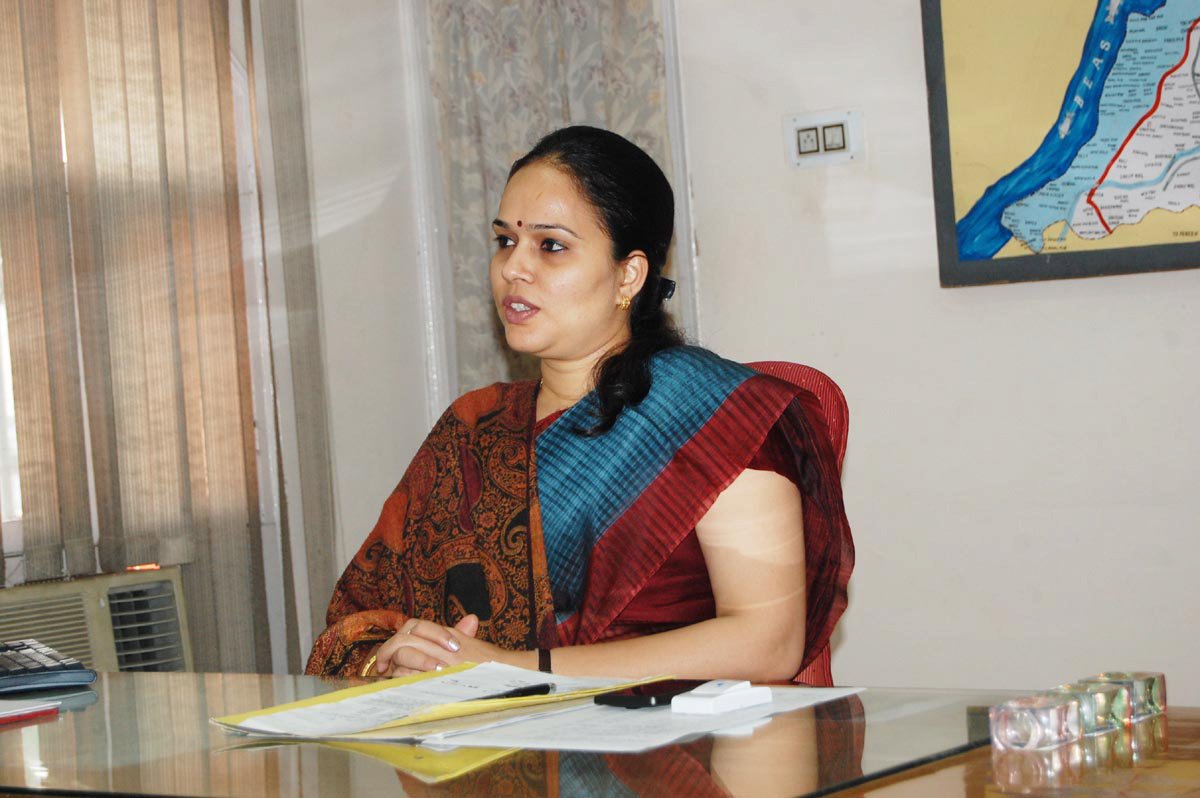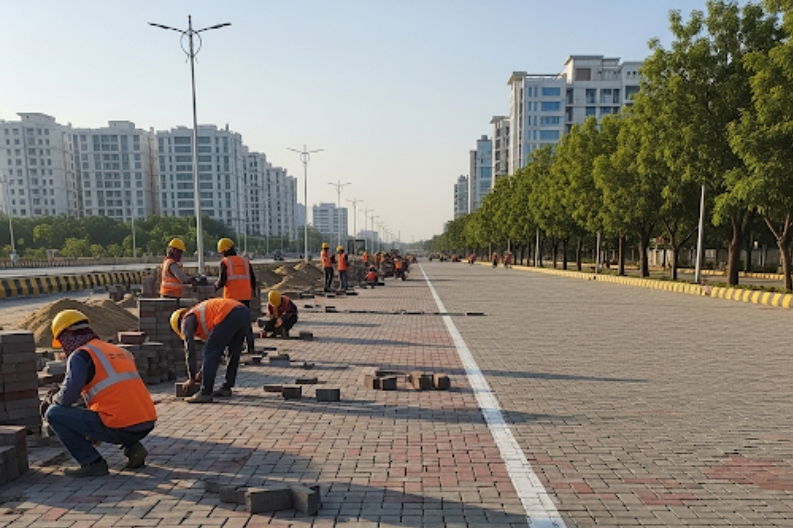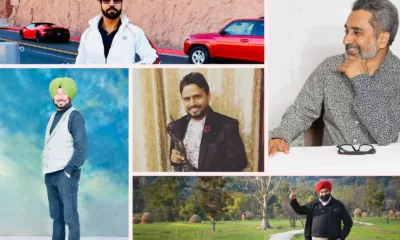Kavita started her educational journey by taking admission to the B.A. (Honours) and then opting for M.A. (Economics). Later on, she gave IAS exams and cleared it. This accomplishment gave her an entry to the esteemed class of 5000 IAS officers in India.
WHAT IS AN IAS OFFICER?
India has around 5000 IAS officers approximately. Kavita Singh is one of those 5000 IAS Officers. The exam required to clear the IAS Exam is called UPSC. UPSC is considered one of the toughest exams in the country and to clear that exam is no small feat on its own. There are lakhs of students who sit for this exam. I would also like to highlight the fact that, students start preparing for this exam even before high school sometimes. Becoming an IAS officer is a great achievement in this country. It is a matter of great pride for the family to have an IAS officer come out of their family. But for a woman to achieve this feat is no ordinary task.
The destination “IAS” itself adds so much respect and glory to the person’s name. Indian Administrative services are one of the 3 arms of the All India Services, along with Indian Police Services (IPS) and Indian Forest Services(IFS). An IAS is a part of the permanent bureaucracy of the nation and is an inseparable part of the executive of the Government of India. It always remains neutral and guarantees administrative continuity to the ruling party.
CURRENT POSITION and INITIATIVE

Source : LBSNAA Website
Kavita Singh overcame all such hurdles in life and took the position of an IAS. Currently, she has been placed at the disposal of the Department of Housing and Urban Development. She has also been appointed as the Chief Administrator of Greater Mohali Area Development Authority (GMADA), SAS Nagar & in addition to Direction Town & County planning relieving Shri Ajoy Sharma IAS.
Earlier Kavita Singh served as the Director of Social Security and Development of Woman and Children. This esteemed lady along with Raju P. Srivastava started a program to provide blankets, clothes, and books to the needy children. Over 500 children have been helped and giving better opportunities to learn and live so far under this scheme.
IAS Kavita Singh is not only a powerful woman but is also a lady with a kind heart. She is always mindful and taking care of the destitute. Even during she is always prompt and alert in her decisions. During winters, she makes sure to keep the animals warms by providing shelter and many other needed things to their caretakers. She always had a soft spot for animals and hence leaves no chance to help them. She arranges special shelters and veterinarian facilities for stray animals.
HELPING NATURE
Poor Children are always under her shadow too. She is famous for providing comfort among poor children. Her whole project started as an experiment, in order to encourage people to help the needy. But slowly but surely this movement has taken an altruistic form, helping hundreds of kids and adults in Children & Observation Homes. All these homes are also run by her department too. She is a woman hero and savior for many.
It all started just before Diwali that they decided to personalize this initiative, and asked their employees to contribute material things which they themselves haven’t used or have little use for. Message and notification spread like wildfire prompting many to donate multitudes of old and new stuff. A chain reaction was started and a continuum was formed. Employees spread the message further to colleagues and friends in the service area. The initiative also got the social attention and many Whatsapp groups were formed in order to fulfill the purpose.
A huge response followed their actions. Books, Stationary, clothes, health equipment, etc were donated by many contributors making this program a huge success.
Though the government has provided budgetary allocation for the basic facilities to the children in these homes, it is never enough. There are hundreds of children residing in such homes. Belonging from poverty-stricken families they have never seen comfort and stability. To provide a better future, stable living conditions, and a healthy environment becomes the government’s responsibility to care for such souls. Then angel souls like Kavita Singh come to their rescue and give them hope.
HER HEROIC PERSONALITY
The heroic saga of Kavita Singh doesn’t end here. She also announced that the department is currently thinking of ways to secure the future of the children who have left or will these homes after coming of age (18 years plus). They said that she hopes that children will be able to take up higher education and manage their own lives but being a productive individual of society.
Planning for making a personal insurance plan for such children is also underway, so they can use it whenever they need it in life.
Kavita Singh gives a message to the society that if a woman makes her mind to do something, then nothing can stop her. She can be the wave of change she wishes to see. We all should take an example from her brilliant story, in order to motivate and inspire ourselves. The way she has become a mother figure for many children across the state and her selfless effort to improve their lives has earned her respect only a few can in their lifetime.
Today a woman is powerful and has the capability to change the toxic mindset of people about a woman. IAS Kavita Singh is not only being dedicated to her duty but has also been putting sincere efforts to provide a satisfactory life for poor children.
Also learn about eProcurement Punjab – How does it Work?
Government
Strict Firecracker Rules in Mohali for Upcoming Festivals
The Mohali district in Punjab is taking strong steps to control firecracker usage during festivals.

ChatGPT Generated (Not a Real Image)
Strict firecracker rules in Mohali for upcoming festivals aim to protect public health and improve air quality during the festive season. The Mohali district administration in Punjab has taken strong steps to reduce pollution caused by fireworks. These measures will apply to popular celebrations such as Diwali, Guru Nanak Dev Ji’s Parkash Purab, Christmas, and New Year’s Eve to ensure safer and cleaner festivities for everyone.
The administration introduced these restrictions under Section 163 of the BNNS, directly banning the sale, use, and storage of traditional firecrackers. However, officials have allowed people to burst approved crackers only during specific hours.
Here are the permitted timings:
- Diwali: 8 PM to 10 PM
- Guru Nanak Dev Ji’s Parkash Purab (November 5): 4 AM to 5 AM and 9 PM to 10 PM
- Christmas (December 25-26): 11:55 PM to 12:30 AM
- New Year’s Eve (December 31, 2025 – January 1, 2026): 11:55 PM to 12:30 AM
District Magistrate Komal Mittal explained that Punjab has completely banned series or chain fireworks, also known as laris. These types of crackers release excessive smoke and noise, which seriously affect air quality and public health. Therefore, only green crackers, which are safer and less polluting, will be permitted.
Green crackers do not contain harmful elements like barium salts, mercury, antimony, or lead. They release fewer toxic gases and create lower noise levels. Moreover, only licensed sellers can trade these eco-friendly crackers. The administration believes this decision will encourage people to celebrate responsibly and help protect the environment at the same time.
To prevent illegal online sales, major e-commerce websites such as Amazon and Flipkart are strictly prohibited from accepting firecracker orders in Mohali. Authorities are continuously monitoring online activities to ensure full compliance with this order.
Meanwhile, the local police and the Pollution Control Department will jointly enforce these restrictions. They will actively check marketplaces and residential areas to stop violations. In addition, the Punjab Pollution Control Board (PPCB) will monitor air quality in different cities and towns. The PPCB will work according to the Central Pollution Control Board (CPCB) guidelines and pay special attention to non-attainment cities, where air quality consistently fails to meet government standards.
Officials pointed out that these restrictions fully align with the rulings of the Supreme Court of India and the National Green Tribunal (NGT). Because of this legal backing, the move carries both administrative and judicial support. It also reinforces the government’s ongoing mission to protect citizens’ health while maintaining environmental balance.
Anyone who violates these firecracker rules will face strict consequences. Offenders can be fined or even jailed under Section 15 of the Environment (Protection) Act, 1986, along with penalties under other environmental laws. The prohibitory orders will remain in effect from October 1, 2025, to January 2, 2026, covering the main festive period.
Environmental experts and health officials have welcomed this decision. They explained that during Diwali and winter, Punjab often experiences a sharp increase in air pollution due to smoke from fireworks and stubble burning. Therefore, these restrictions will likely help reduce harmful gases and dust particles in the atmosphere. Moreover, schools, NGOs, and local communities are promoting awareness campaigns about celebrating festivals with fewer crackers and more sustainable practices.
Ultimately, strict firecracker rules in Mohali for upcoming festivals reflect the Punjab government’s firm commitment to cleaner air and safer celebrations. With collective cooperation from citizens. These measures can create pollution-free festivities, protect public health, and ensure a healthier environment for future generations.
Government
Haryana Launches an Important Plan for a Greener Future
In a significant step towards protecting the environment, Haryana’s Chief Minister Nayab Singh Saini announced the State Environment Plan (SEP) 2025-26 on Tuesday.

ChatGPT Generated (Not a Real Image)
In a significant move for sustainability, Haryana launches an important plan with the introduction of the State Environment Plan (SEP) 2025-26. Announced on Tuesday by Chief Minister Nayab Singh Saini in Panchkula, this initiative aims to make Haryana a leader in environmental protection and future-ready development. The plan focuses on achieving Sustainable Development Goals (SDGs) with clear targets to improve living conditions across the state.
The SEP is more than just a framework. It includes a detailed study of Haryana’s environmental condition. The focus areas are agriculture, waste management, transport, industry, and pollution control.
The State Pollution Control Board worked with the Indian Green Service Development (IGSD) and the Energy and Resources Institute (TERI) to draft this plan. A key highlight is the report A Dual Strategy Sprint Towards Sustainability. It calls for reducing both carbon dioxide emissions and short-lived climate pollutants. This approach will improve air quality and aligns with regional efforts in Punjab.
Waste management forms another crucial part of the SEP. It introduces 13 Integrated Solid Waste Management Plants to tackle growing urban challenges in cities like Mohali and Chandigarh. The plan also emphasizes improving water and air quality, which are vital for public health and well-being.
Officials noted that every component of the SEP will help Haryana use resources wisely while promoting long-term sustainability. The initiative shows the state’s proactive stance against pressing issues such as pollution, waste, and resource depletion.
The timing of this plan is vital. Global awareness of environmental challenges is growing quickly. By using innovative solutions and involving both institutions and citizens, Haryana aims to become a model state for eco-friendly growth.
Chief Minister Saini’s vision for a greener Haryana is clear in this bold step. The SEP seeks to protect resources and inspire communities to adopt sustainable practices.
In conclusion, Haryana launches an important plan that acts as a blueprint for future growth rooted in environmental responsibility. With strong policies, organizational support, and citizen involvement, the state is paving the way for a healthier tomorrow.
Government
Haryana CM Announces New Paver Block Roads in Panchkula
Improving Roads in Panchkula
On Monday, Haryana’s Chief Minister, Nayab Singh Saini, made an important announcement.

Improving Roads in Panchkula
On Monday, Haryana CM Announces New Paver Block Roads as Chief Minister Nayab Singh Saini ordered the construction of new roads in Panchkula district. These roads will replace the old, dusty “kutcha” roads and benefit 19 villages in the hilly areas of Morni and Kalka.
Panchkula is about 20 kilometers from Chandigarh. This makes it an important link between Haryana and Punjab. The new roads will help make travel easier for many people living in the region.
Details of the Road Projects
The Chief Minister has directed that a total of 61 kilometers of roads be paved. Each of these roads will be 12 feet wide. This width will help ensure smooth traffic flow for both locals and visitors.
- The road upgrades include:
- Panipat-Safidon (41 km)
- Safidon-Jind (21.65 km)
- Saha Chowk-Panchkula-Yamunanagar (four-lane road)
- Saha Chowk-Kalpi
- Tohana-Ratia
These upgrades will not only make travel easier but also improve safety for everyone using the roads.
Additional Road Projects
Beyond the 61 kilometers of paver block roads, Saini has asked officials to speed up work on several more road projects in Panchkula. These include:
- Thapali Badisher-Koti (1.68 km)
- Pinjore Mallah-Mangniwala (1.20 km)
- Gobindpur-Thathar (5.35 km)
These projects aim to enhance connectivity in Panchkula and support the growing population.
Next Steps for the Construction
During a review meeting with officials from the public works and forest departments, Saini emphasized the need for timely action. He instructed that work should begin quickly after obtaining a no-objection certificate (NoC) from the forest department. This certificate is necessary for construction in areas with trees and wildlife.
Principal Secretary to the Chief Minister, Arun Gupta, and Additional Chief Secretary (PWD), Anurag Agarwal, were present at the meeting. They discussed strategies to ensure that the projects are completed efficiently and on time.
Background on Panchkula
Panchkula is not just another town. It is part of the larger region around Chandigarh, which is known to be one of the cleanest cities in India. Cleaner cities often produce better living conditions and infrastructure for nearby areas, like Panchkula. The development of new roads will help improve civic services and support the needs of residents.
The Impact of Better Roads
Better roads mean more than just smoother driving. They connect communities, help businesses grow, and make it easier for people to access education and healthcare. For the hilly areas of Morni and Kalka, these roads will make it easier for residents to travel to nearby towns and cities.
Local farmers can transport their goods more easily. This can lead to increased sales and better incomes. Students will also find it easier to reach schools and colleges. Parents will have less worry about how their children get to school.
The Future of Infrastructure in Haryana
The move to replace kutcha roads with paver blocks is part of a larger plan. The Haryana government is focusing on improving rural infrastructure. This effort aims to boost the local economy and improve the quality of life for people living in these areas.
As more projects like this are developed, the future looks bright for the communities in Haryana. Residents can look forward to better roads, stronger connections, and improved services.
Conclusion
In conclusion, Haryana CM Announces New Paver Block Roads, marking a positive step for Panchkula. The construction of 61 kilometers of new paver block roads will greatly benefit the region. With prompt action and good planning, these improvements will help transform the lives of many people living in the hilly areas of Morni and Kalka.
-

 Entertainment2 years ago
Entertainment2 years agoTop 15 Punjabi Models – Male and Female List
-

 City Guide3 years ago
City Guide3 years ago3B2 Mohali Market Shops: Discover 44 Hidden Gems
-

 Entertainment2 years ago
Entertainment2 years agoTop 11 Punjabi Comedians of All Time
-

 Jobs4 years ago
Jobs4 years agoTop 20 IT Companies in Mohali
-

 Food4 years ago
Food4 years ago11 Best Restaurants in Mohali You Must Visit
-

 Property2 years ago
Property2 years agoWho Lives In Homeland Mohali: Punjabi Celebrities, Business People…
-

 Food3 years ago
Food3 years agoTop 15 Cafes in Mohali you must visit
-

 Education2 years ago
Education2 years ago10 Famous Punjabi Writers With A Great Impact On The Literary World
